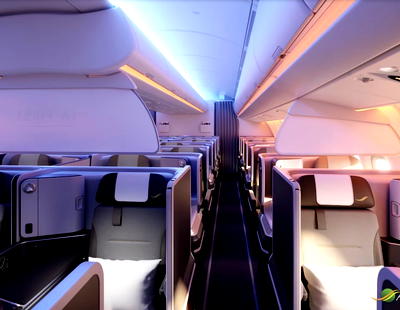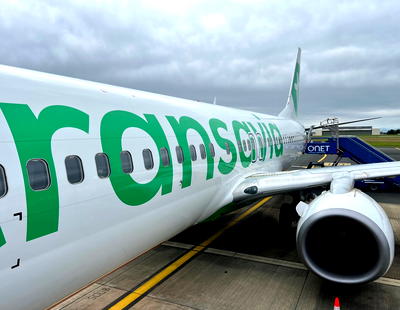I suppose all is well that ends well, though at a minimum this is a strange occurrence.
In this post:
Swift Air 737 lands with tail part missing
Airplane spotter Doug Kempf photographed planes landing at San Diego Airport on runway 27 this past Tuesday, May 19, 2020, and spotted one particularly strange landing. A Swift Air Boeing 737-800 landed with a part of the vertical stabilizer missing.
N820TJ Boeing 737-8Q8 operating as Swift Air/iAero Airways SWQ3518 landing KSAN runway 27 on 19 May 2020. I would have discarded this photo except for the tail. Evidently it is airworthy. #avgeek #planespotting pic.twitter.com/Tnfk7osdF8
— Doug Kempf (@dougkempf) May 20, 2020
For what it’s worth, the plane in question has registration code N820TJ, which is a ~22 year old plane that entered service in 1998 (and has flown for a long list of carriers).
Swift Air (now officially iAero Airways) is a charter airline with a fleet of over 30 Boeing 737s. The airline operates all kinds of charter flights, including for sports teams, tour operators, and even deportation flights.
What exactly happened, though?
When I first saw this picture I thought to myself “well, I guess the plane is airworthy even with a lower part of the vertical stabilizer missing, and they determined it was safe to fly.” But that doesn’t appear to be the case.
The plane was operating flight 3518 from Victorville to San Diego, which was a short 41 minute flight. While Victorville is often known as a graveyard and store facility for planes, this plane wasn’t coming out of storage — the same day the plane had flown from Phoenix to Denver to Victorville.
Perhaps Swift Air was contracted to fly workers to & from Victorville? We don’t actually know if there were passengers on the flight to San Diego.
What we do know is that the plane took off from Victorville with the tail fully intact, meaning that the damage occurred inflight. The crew apparently wasn’t aware this happened until after landing, though the plane hasn’t flown since.
Bottom line
A part of a Boeing 737 tail came off mid-flight, and the crew apparently wasn’t aware. Thank goodness it wasn’t a more critical part of the tail that fell off.
I’m not sure how much danger the plane was (unknowingly) in, though I would think there’s some risk of a part hitting the vertical or horizontal stabilizer and causing more damage.
I’ll be curious to see what an investigation reveals…





@LUCKY
don' know if you have seen this - its a report on the flight of the Titan A318 from UK to St. Helena
https://whatthesaintsdidnext.com/titan-airways-airbus-a318-delivers-covid-19-test-kits-st-helena-island/
All aircraft have something called a configuration deviation list which allows planes to take-off with things such as panels and fairings missing; I recall years ago there was a Thomas Cook A330 flying around with a winglet missing, completely safely. While parts falling off an aircraft in flight is never a good thing, it is likely the designers will have anticipated such an occurrence and built in some redundancy, in this case to the design of the tail.
Surfer - dude... why do u even bother reading the blog, nothing else to do, huh?
“well, I guess the plane is airworthy even with a lower part of the vertical stabilizer missing, and they determined it was safe to fly.” But that doesn’t appear to be the case.
Says the internet blogger with zero hours flying airplanes. Second time in a week just like the 6 Chinese pilots flying “irresponsibly“ which was subsequently edited...
Don’t become TPG
I flew on a AA 320 and part of the trailing edge of the wing was missing. Snapped a picture of it.
If you zoom into the photo it appears the vertical stabilizer has some damage that may have been caused by the fairing falling off mid-flight.
If it fell in my yard could I keep it?
There are all sorts of fairings, coverings, latches, antennas etc. that can be missing from an aircraft with ZERO impact to the overall operation and safety of the aircraft.
This is one of those.
It is not structural, it is not mechanical, it's simply a fairing to streamline and reduce drag between the top of the fuselage and the vertical stab.
Regardless if it was on the aircraft before it departed or not, at...
There are all sorts of fairings, coverings, latches, antennas etc. that can be missing from an aircraft with ZERO impact to the overall operation and safety of the aircraft.
This is one of those.
It is not structural, it is not mechanical, it's simply a fairing to streamline and reduce drag between the top of the fuselage and the vertical stab.
Regardless if it was on the aircraft before it departed or not, at no time would this aircraft be any less airworthy during any phase of flight.
@Chris - The fairing on the leading edge of the vertical stab (and the skin on its sides) which were missing upon landing, were both in place when the flight took off. They're visible in one of the photos.
I dont know the MEL for the 737 but its also possible it was operated under a ferry permit. I do know that a flap track fairing on the DC-9 is an MEL item.
photoshop
The aircraft was not in VCV for maintenance, but was for a charter. It then repositioned to SAN for another charter, which has been covered by a different aircraft. The leading edge fairing on the vertical stabilizer came off during the descent and the resulting airflow into the stabilizer caused some side panels to blow out as designed. Either the side panels or the fairing also impacted the horizontal stabilizer damaging it as well. It...
The aircraft was not in VCV for maintenance, but was for a charter. It then repositioned to SAN for another charter, which has been covered by a different aircraft. The leading edge fairing on the vertical stabilizer came off during the descent and the resulting airflow into the stabilizer caused some side panels to blow out as designed. Either the side panels or the fairing also impacted the horizontal stabilizer damaging it as well. It is not clear if something impacted the aircraft causing the damage seen.
It is interesting that the flight crew noticed not change in behavior of the plane throughout. Either the change was imperceptible compared to other feelings that might normally be encountered due to weather, turbulence, etc or it simply did not cause a problem. According to the air frame chart that triangle piece attaches separately to the empennage so it is theoretically possible it had a negligible effect on the stability of the plane. Probably more...
It is interesting that the flight crew noticed not change in behavior of the plane throughout. Either the change was imperceptible compared to other feelings that might normally be encountered due to weather, turbulence, etc or it simply did not cause a problem. According to the air frame chart that triangle piece attaches separately to the empennage so it is theoretically possible it had a negligible effect on the stability of the plane. Probably more as an aerodynamic device than a structural device. Interestingly it does appear to have broken away nearly cleanly as though it was taken off and not replaced.
Maybe they went to VCV to get some spare parts and left some other parts along the way.
OK, found a photo via the Twitter link further down in the post (linked from "What we do know").
Direct link to the image here:
https://pbs.twimg.com/media/EYkakSUUwAAl5MN?format=jpg&name=small
Yeah, that's pretty strange, and fairly disturbing. I fly old airplanes and have a fairly high freak-out threshold compared to most people, and this looks pretty worrisome to me - there's going to be a lot of aerodynamic forces at play with the skin gaps around the...
OK, found a photo via the Twitter link further down in the post (linked from "What we do know").
Direct link to the image here:
https://pbs.twimg.com/media/EYkakSUUwAAl5MN?format=jpg&name=small
Yeah, that's pretty strange, and fairly disturbing. I fly old airplanes and have a fairly high freak-out threshold compared to most people, and this looks pretty worrisome to me - there's going to be a lot of aerodynamic forces at play with the skin gaps around the base of that vertical stabilizer. Hmmm.
Got a photo showing it?